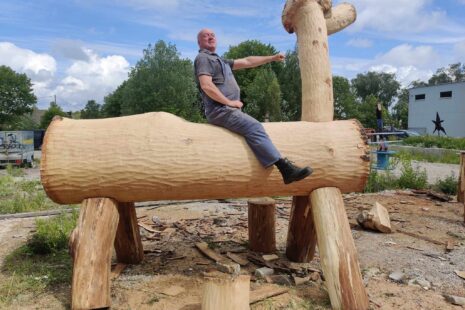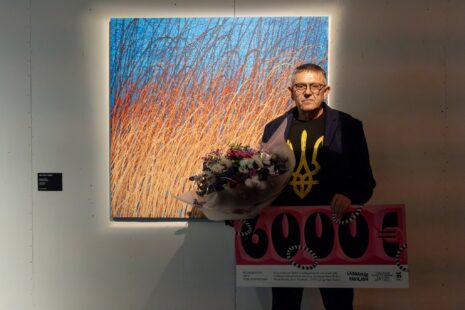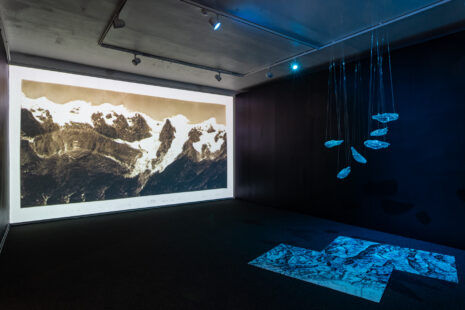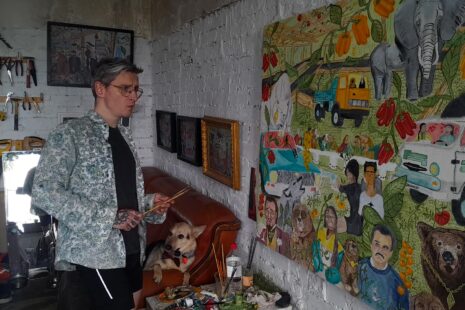Jānis Šneiders (b. 1995) graduated from the Art Academy of Latvia, faculty of painting, and is currently working on an MA in Audio-Visual Media Art. He has held 9 personal exhibitions and more than 30 group exhibitions, both in Latvia and abroad. For his solo exhibition Vieta (gallery LOOK!) he was nominated for the most prestigious Latvian prize in fine arts – Purvitis Prize 2021. His works can be found in private collections in Latvia, Estonia, Germany, Belgium, and Luxemburg.
Some of his works have also been acquired by the Latvian National Museum of Art and Secco Pontanova foundation art collections. In 2019, he received the Nordic & Baltic Young Artist Award in painting, and in 2020, in Berlin, he received the prestigious Secco Pontanova foundation Claus Micheletz – Preis 2020 award.
During the interview, Šneiders talked about his exhibition The Book of Sand at Meno Niša gallery, the Lithuanian art scene, and his daily inspirations.
The Book of Sand is your first ever exhibition/appearance in Lithuania. Can you tell us more about the collaboration between Riga’s Look! gallery with Vilnius Meno Niša gallery?
I had just won Secco Pontanova Prize and was at the Positions Berlin art fair as part of the prize with Raivis Alksnis from the Look! gallery. He approached the Meno Niša gallery there, and together they came up with a plan for collaboration – one of the artists from their gallery would come to Riga, and one from Look! would go to Vilnius. Jurgis Tarabilda came to the Look! gallery to show his work, and I came to Meno Niša to show mine. I think it’s a really nice opportunity for both countries to have a look at what’s happening in the art scene in a neighbouring country because we rarely do. Also – it’s a chance for the artists to become more recognized.
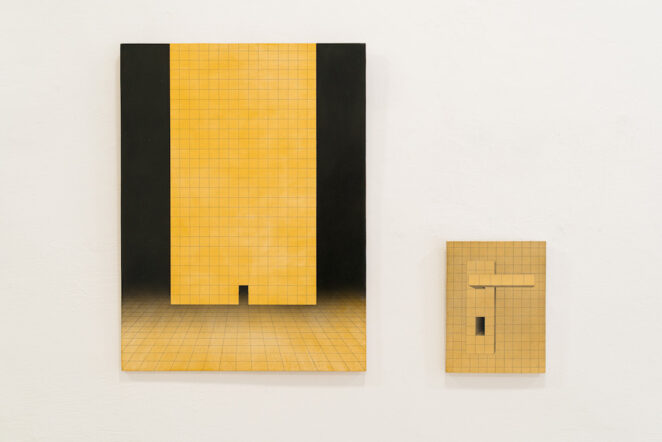
The Book of Sand at Meno Nisa gallery in Vilnius. Photo by Andrej Vasilenko.
What do you think about the Lithuanian art scene in general?
Whilst in Vilnius, I went to the MOA to see Andrew Miksys’s photography exhibition BAXT about the Romani people in Lithuania, and I enjoyed it a lot, it hit close to home. I rarely like anything, most of all art leaves me indifferent, but when I do like something, I like it intensely. I love the empty spaces of Patricija Jurkšaitytė, I see a lot of similarities with my own work there. And Jurgis Tarabilda is a breath of fresh air.
Other than that – I haven’t had the chance to explore Lithuanian art or learn about it as much as I would like to. I hadn’t been to Lithuania for a really, really long time, and when I came to Vilnius for the exhibition, it felt familiar, but in a dreamlike way – had I been here before? What had I seen? I find it weird that the most popular place everyone from Latvia goes to at one point whilst in school is the Dolphinarium in Klaipėda, and everyone remembers that. I would prefer to see some museums. If I remember correctly, I saw Čiurlionis in Kaunas, and that is all my memory holds.
I would love to visit Vilnius again and explore it more, it’s a beautiful city, and I wish to visit Kaunas this year as well. So you could try asking me this question after a year. And now that Valdas Puteikis has made me a friend on Facebook, I get to see some more Lithuanian art in my feed, so that’s nice.
After graduating from the Art Academy of Latvia’s Faculty of Painting, you are currently studying in the field of audiovisual media art. Why did you decide not to continue your studies in the same painting field?
I had been studying painting for more than 12 years – starting with my hometown’s art school, continuing with Janis Rozentals Art High School and Art Academy of Latvia. I look at paint as a sort of animal. You have to pat it, caress it a certain way so it does what you want it to do, so it purrs and obeys, otherwise it might bite you, might make you angry. You have to get to know it, to spend time with it, to become friends with it. I felt we were good enough friends already. I had learned the ways to achieve what I wanted in a painting, and still, I continue to learn the craft on my own. I have always been interested in digital art as well – 3D modelling, digital drawing, videos, games. Mainly I just wanted to expand my abilities in other directions, and I thought that actually studying them at the academy would be easier – I lacked the motivation and the necessity to study it deeper in my free time. I also think that making 3D models has helped me with painting as well – it’s really easy and fun to move light sources around a virtual space, change the materiality of objects, look at all the interesting ways light reflects off surfaces and onto other objects – it’s all useful. Still, I always come back to painting and drawing, I can’t escape it anymore! I have been doing it for so long that I sometimes catch myself vaguely moving my arms and fingers while looking at something, moving them in ways I would move a brush if I were to paint it.
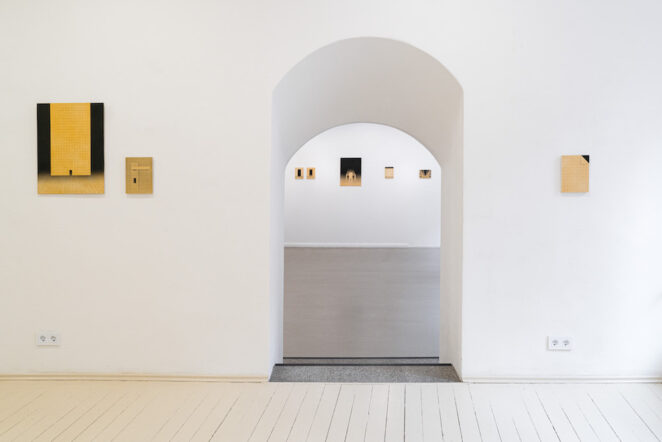
The Book of Sand at Meno Nisa gallery in Vilnius. Photo by Andrej Vasilenko.
In your paintings, you take components of our daily lives to turn them into metaphysical realism. Was this your theme for a long time, and how did your style/themes evolve?
It has been my theme for a long time, just the way I depict it has changed. I used to make realistic paintings of real objects, one object per canvas, almost never compositions of many. No matter how “real” I tried to make the painting, I always saw too much of myself in the work. There was this… crookedness, a sort of style I did not want, a kind of handwriting that others did not mind or see, only I. Some artists say that you learn to love it, and it becomes your style. I did not want a style, I just wanted to get closer to the thing I depicted. When you paint a thing, you spend time with it, and it becomes immense, full of meaning. I thought I showed dignity for the person or object I painted, I start to appreciate the model a lot more, it is worth spending time with it, but the “style” kind of ruined it for me, it always was just a parody of reality, as if I was a criminal, robbing the reality of itself, filling it up with myself, with what I know of it, with my flawed human view of it. The flower I painted probably did not have the same amount of petals as the real one, no bee would fly to it, and the door I painted may never be opened. I could spend an eternity on one piece and never be happy, because of the logical limitations of a two-dimensional depiction, the limitations of not being a god.
The limitations became a theme itself. I tried to accentuate the impossibility to see around a painted corner or to light up the painted darkness. I have always found it funny that you need an external light source to see a painted candle or a painted shadow.
I mean, people talk of a style I have now, but I have tried to remove myself from the works as much as I could. I just made the rules, made a place that is non-existent but abstract enough to exist everywhere my place, so I wouldn’t need to make a parody of reality again. The grid just seemed the most simple, the most neutral and naked way to make space. In a way it is not my handwriting anymore, it’s the writing of a ruler, of straight lines, of centimetres, of mathematics, and the most basic rules of one-point perspective. The vanishing point is usually centred – that seemed the most neutral, documentary placing, like a passport photograph. Using a ruler is another way to escape seeing the work as a mirror. Still, there are imperfections – and those are me in the purest form I guess. And I am finally okay with that because those imperfections have also become a part of the theme. I don’t leave my signature on the front of the works anymore, I like to think they just suddenly appeared on their own, that I found them.
The one thing I have learned while working on the series is that everything is a little crooked, and you can find ease in that. Even the rulers I use haven’t been perfect – once I ruined a piece because one of the rulers was missing a millimetre. It was a relief! I as well am missing a millimetre.

Jānis Šneiders. Slit. Pencil, acrylic ink, oil on wod. 2022. 18×24 cm
The concept of your exhibition The Book of Sand is very interesting, drawing inspiration from Argentinian writer Jorge Luis Borges’ short story collection El libro de arena. Can you tell us more about the concept of the exhibition? How did you discover Jorge Luis Borges?
I discovered the short story collection when I was quite young. I remember it had nice covers – a golden paper dust jacket with a fragment of Botticelli’s Primavera, and I really liked the title. As for the stories – I did not really like them, I found them difficult, they made me sleepy and for the most part, I just did not get them. Last year I was reading George Perec, and he made me turn to Italo Calvino, and Italo Calvino made me give it a second try to Borges, and it did not disappoint.
The protagonist of The Book of Sand gets a hold of an infinite book – there is no beginning nor end, the pages bloom in it, each differently. He becomes terrified of the book, it breaks his concepts of reality, so he gets rid of it.
When I sit in front of a blank primed board, I can go anywhere. I can start the line from any point of the given area, maybe not even a line, I could make a dot or even write something, I could use a pen or a pencil, but I could also use a knife and scrape my way in, I could kiss the surface, or I could burn it. The possibilities are infinite, and it is terrifying! I could even continue the line over the board, continue it on the table, out through the door, through the staircase, and out the apartment building, continue my way to Ukraine and stab a Russian drone with a pencil or something. Once you get that, everything shifts – each step you make is a letter in the book of sand.
I also consider my works as writings of space in a space, a kind of spatial language. If a perfect, perpendicular grid is complete silence, a still sea, after you throw a rock in it, it starts to speak. The first works were kind of like letters, an alphabet of space – basic elevations and recesses of a few squares. Afterwards, they became words and sentences, and the works began to speak to each other, continuing behind the surface, in the negative space around them as well. A place without beginning nor end.
From where do you take inspiration for your art in general? What are your other interests/hobbies?
My favourite museum is all around – in my room and behind the window. The exposition is constantly changing, each day there is something new to see. I get most of my inspiration there, although sometimes it comes in the form of a dream, a word, or a situation.
I often look at myself as a place, some things are hidden in drawers, some doors are open, some are locked – the right words or touch may work as a key.
I am pretty sure the genesis of the darkness, vastness, and warm light in my works lies somewhere in the misty Silent Hill, nightmares of dim light, and House of Leaves by Mark Z. Danielewski.
I enjoy reading, playing video games (I think they are usually looked down upon, but some games are really amazing works of art), watching movies, taking long walks on the same paths, and looking for changes in the scenery. If I had to say what had the biggest impact on me in the past year, I would have to mention Italo Calvino’s Cosmicomics, Borges’s stories, and Hideo Kojima’s game Death Stranding. I am also not as interested in architecture as it might seem.
After starting the series a few years ago, I have been finding more and more similar works to mine – old and new. That’s the thing – once you do something long enough, you see it everywhere. There are these trending videos on YouTube about an urban legend called Backrooms, and they as well match my works quite nicely.
I would like to mention the author Ted Chiang as well. His stories also deal with concepts that are difficult or impossible to imagine and wrap your head around, and I really enjoy that, it reminds me of times I randomly “zoom out”. I see myself spinning on this blue ball in space, zooming further and further away, and my knees would get weak. That’s the feeling! It makes life big again.
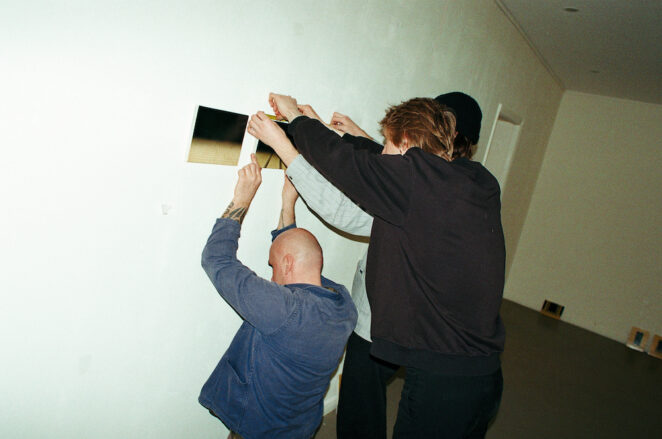
Photo by Kārlis Didrihsons
Can you tell me more about the painting technique of The Book of Sand, where you use acrylic ink, oil on wood, and pencil? Is the technique your discovery or has it been taken from somewhere else?
A good friend of mine, great artist Zile Ziemele, taught me a timeless technique for priming a wooden board with chalk and gelatine, so that comes from her. I apply the ground in many layers and sand it down as smoothly as I can. It is quite an exhausting process, but I prefer the stiff, smooth surface of a wooden board to canvas. I have tried to make these works on canvas as well, but I disliked the texture the pencil made, and the canvas would stretch out if enough lines were drawn on it, making a weird fish-eye effect – I could never be precise enough.
I make the drawing with a pencil and a ruler, trying my best to be precise. I am really concentrated while doing it. It gets meditative but can become tedious if done too long.
Afterwards, I use a lot of painter’s tape to mask the lighter parts of the work, then I spraypaint the darkest parts, the gradients with acrylic ink, then peel the tape off piece by piece, continuing to spray the darkness in the distant areas. I never see the work “as it is” while doing it, only after I’ve peeled off all the tape can I see if I’ve messed up. After that, I cover the work with a “wash of oldness” using oil paint.
I highly doubt I am the only one using this technique. Right now it’s just the most convenient way I have found to do the job. I am not completely satisfied with this technique, there are always aspects to improve, and I continue to find new ways to make my work better.
There are also some accidents. They happen! If I spraypaint something too dark, it’s impossible to make it lighter again – the process is irreversible. I have to then choose between sanding everything down back to white and starting again or forgiving myself for being only human. So you could say that some of the works are also about forgiveness.
I am also turning back to older texts on the craft of painting, Leon Battista Alberti’s On Painting and Cennino Cennini’s The Craftsman’s Handbook – they are still full of useful tips I plan to apply to my own work.

Jānis Šneiders. Kremlin. Pencil, acrylic ink, oil on wod. 2022. 60 x 45 cm
What about the Chiaroscuro in your works? Is it created by accident without such intentions, or is it a hidden hint to the old paintings?
Chiaroscuro is usually achieved with a light source coming from the side, like a ray of light, or a lamp in a painting, so the shadows get really dramatic. In my works, the light is coming from the person viewing the work, and there are usually no shadows dropping from the objects (if there are, they have a meaning), it is more like a gradual darkening in the distance – the easiest way I thought of for depicting a surface without an end.
In 2019 you received the Nordic & Baltic Young Artist Award prize in painting, and in 2020 at Berlin’s Positions art fair, you received the prestigious Secco Pontanova foundation Claus Micheletz – Preis 2020 award. How much do you think these international awards contribute toward your artist development?
A lot! The money prize was a nice push that allowed me to move to a bigger flat, so now I don’t have to paint, eat and sleep in the same room, and I am really grateful for that.
In terms of recognition, I think the awards contribute even more. I get pretty enough e-mails and calls with reasonable offers, and I have to turn some of them down because I find it challenging to keep up with the tempo. I am more of a cave dweller, I prefer shadows to sunlight, but the ray of light has been quite intrusive.
To close up, can you tell us more about your plans?
I wish to finish my master’s studies this semester. I hope it will work out, for I am a slow worker who tends to think too much. There is a plan of making a mural painting in the city of Bauska in Latvia, going to Positions art fair in Berlin, and also having a solo show there at the Jarmuschek + Partner gallery.
I feel as if everything has been given to me on a silver platter – I’m just sometimes not sure if I can take it all. It also felt difficult to find a reason for making art in times of war, but then again – art is a sign of freedom, and that seems reason enough to continue making it even in times like these.
Jānis Šneiders’ painting exhibition The Book of Sand at the gallery Meno Niša will be open from 7 to 29 April. The exhibition is organized by the galleries Meno Niša and LOOK! The exhibition project is sponsored by Vilnius City Municipality.


